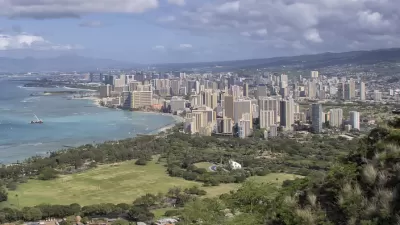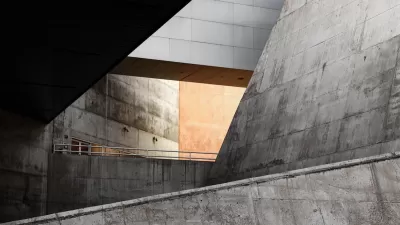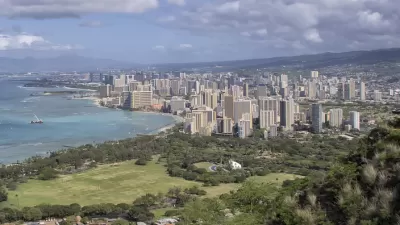Despite its immeasurable geographic and cultural distinctiveness, there is perhaps no American city that has embraced Modernist city planning as fully as Honolulu has.

"The Corbusian connection struck me most acutely when I realized on my recent trip that many of Honolulu’s towers, both in Waikiki and throughout the rest of the city, sit atop open-air lobbies, of the very sort that Corbu said would bring healthy breezes to the masses. I suppose it makes sense in Hawaii, with the trade winds and all, but the effect is still deadening. Ground floors are given to parking areas. Towers are surrounded by pointless greenery and setbacks, making them mutually hostile towards each other. Curb cuts interrupt the sidewalk and, in many neighborhoods, there’s really nowhere to walk to."
"Honolulu should be the most distinctive city in the country. It is literally an island unto itself. In fact, it’s the most isolated big city in the world. I would have thought that a city on an island would embrace efficiency and create dense, lively places in order to conserve scarce land, the way Hong Kong or San Francisco does. Instead, Honolulu looks like Houston with volcanoes."
"Of course, all of these places reflect their historical eras and the prevailing fashions when they were built. That’s another reason I’m sad about Honolulu. It was invaded too soon, before the native culture had a chance to make a lasting architectural impact. It was built too late, without much of an old compact downtown to provide refuge from the auto-oriented, suburban form that just happened to dominate at the very moment that Hawaii became a state and its (non-native) population boomed."
FULL STORY: Reconsidering Paradise: How Honolulu Became a Poster Child for American Autocentric Urbanism

Study: Maui’s Plan to Convert Vacation Rentals to Long-Term Housing Could Cause Nearly $1 Billion Economic Loss
The plan would reduce visitor accommodation by 25,% resulting in 1,900 jobs lost.

North Texas Transit Leaders Tout Benefits of TOD for Growing Region
At a summit focused on transit-oriented development, policymakers discussed how North Texas’ expanded light rail system can serve as a tool for economic growth.

Why Should We Subsidize Public Transportation?
Many public transit agencies face financial stress due to rising costs, declining fare revenue, and declining subsidies. Transit advocates must provide a strong business case for increasing public transit funding.

How to Make US Trains Faster
Changes to boarding platforms and a switch to electric trains could improve U.S. passenger rail service without the added cost of high-speed rail.

Columbia’s Revitalized ‘Loop’ Is a Hub for Local Entrepreneurs
A focus on small businesses is helping a commercial corridor in Columbia, Missouri thrive.

Invasive Insect Threatens Minnesota’s Ash Forests
The Emerald Ash Borer is a rapidly spreading invasive pest threatening Minnesota’s ash trees, and homeowners are encouraged to plant diverse replacement species, avoid moving ash firewood, and monitor for signs of infestation.
Urban Design for Planners 1: Software Tools
This six-course series explores essential urban design concepts using open source software and equips planners with the tools they need to participate fully in the urban design process.
Planning for Universal Design
Learn the tools for implementing Universal Design in planning regulations.
City of Santa Clarita
Ascent Environmental
Institute for Housing and Urban Development Studies (IHS)
City of Grandview
Harvard GSD Executive Education
Toledo-Lucas County Plan Commissions
Salt Lake City
NYU Wagner Graduate School of Public Service





























